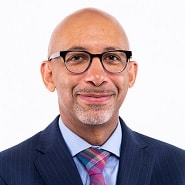
Zafar Chaudry, MD, SVP & Chief Digital Officer, Seattle Children’s
As the world continues to reopen nearly two years after the initial Covid-19 spikes crippled healthcare organizations, leaders are finding that while some of the changes brought on by the pandemic are being phased out, some are most definitely here to stay.
One of those, according to our panelists in a recent discussion, is the hybrid work model. “We know we’re going to stay in hybrid mode,” said John Henderson, CIO at CHOC Children’s. “We fully expect it.”
Not only do employees — both in IT and clinical departments — want the ability to work remotely, but they want to work comfortably and efficiently, with the same level of technical and emotional support they’ve always had.
“The immersive experience is key,” said Zafar Chaudry, MD, Chief Digital Officer at Seattle Children’s, who also spoke on the panel, along with Susmit Pal, Healthcare Field Director with Dell Technologies. “We’re fighting for talent in the IT and the clinical space. If you don’t provide the best experience and the flexibility that people want in today’s environment, you will lose out.”
At Seattle Children’s about 75 percent of IT workers who pivoted to remote work at the start of the pandemic plan to make it a permanent arrangement — and have the organization’s full support. “We’ve been able to provide the technology to connect them, no matter where they work from. I think that’s the future for us as a health system.”
Enabling this future, however, requires a multifaceted approach around people, process, and technology, according to Chaudry and Henderson, who detailed their experiences during the webinar, and provided best practices for navigating the hybrid world.
Technical support
One of the key factors in maintaining a high level of user satisfaction is support, which Seattle Children’s aims to achieve by giving every employee a Remote Work Toolkit that includes any equipment they may need, along with access to a 24/7 service desk. “We spent a lot of time building out that program,” noted Chaudry, who believes that by reducing physical office space and cancelling leases, the organization can save as much as $100 million over the next 10 years.

John Henderson, VP & CIO, CHOC Children’s
It does, however, mean allotting funds upfront to ensure staff have not just the right tools, but also adequate connectivity. At CHOC Children’s, Henderson’s team aims to achieve this by granting technology stipends for equipment and providing step-by-step instructions on how to increase connectivity speeds or improve video capabilities. “We give a lot of recommendations to help people feel comfortable.”
Physical support
Not all challenges, however, involve technology. For many individuals, ergonomic issues — such as the lack of a dedicated workspace or suitable chair — have been a source of discomfort. And so, as part of its work from home program, Seattle Children’s has provided each employee with a $500 stipend to purchase a chair or desk, in addition to offering “hotel” space for those who need a quiet environment.
At CHOC Children’s, Henderson’s team contracted with a third party that conducts assessments for those who have designated work spaces and offers coaching and tips on how to improve ergonomics. “It’s been really well-received,” he said.
Another pain point is conference rooms, which for the most part “are not configured for a seamless and integrated experience,” according to Henderson. To that end, CHOC Children’s is piloting a redesigned concept that eliminates round tables in hopes of creating “more of a telepresence-like experience.” It’s yet another example of the evolution the CIO role has experienced in the past two years, he noted.
“Obviously, we have to bring new technology, keep the lights on and keep the day-to-day running, but we’re driving everything that a hospital needs to do for the future,” he said. “All of our top-line strategies are heavily driven by technology enablement.”
Human support
A critical part of that, according to the panelists, is managing the human element. And although there are no one-size-fits-all solutions, there are best practices that can be applied.
- Clear messaging. Organizations that adopt hybrid models need to communicate expectations to the staff and be consistent, said Chaudry. “I’ve seen a lot of back and forth in this domain where companies tell people to come into the office, then change it two days later. You need to be consistent, and the messaging from leadership has to be clear.”
- Mandated breaks. At Seattle Children’s, leadership strongly advocates for breaks in-between meetings to help avoid Zoom fatigue and other forms of burnout. “We’ve set our calendar meeting defaults to less than a full hour and less than 30 minutes” to guarantee time for a breather — even if it’s just five minutes. And although these types of policies can help enormously in the long-term, leaders shouldn’t expect them to take hold right away, Chaudry cautioned. “It’s a really hard thing to change, from a culture perspective. We struggle with it. We’re making progress, but it’s a big shift.”
- Meeting-free days. CHOC Children’s has taken it one step further by eliminating meetings on Fridays — a request that came from the frontline staff, according to Henderson. “They asked for it, and so we’ve been really intentional about sticking to it,” even if it means having uncomfortable conversations. “I’ve had to say, ‘I know you want my folks in a meeting on Friday, but they’re not going to be able to make it.’ We’ve cleared that day.”
- Checking in. It’s also critical, said Henderson, for leaders to make sure managers are checking in with their teams to see they’re not too overwhelmed. And while it’s important to set aside specific times to talk — as he does with weekly calls and happy hour events — it’s just as critical to connect informally. “People need to feel comfortable and feel like they’re connected with one another,” he said. “It’s really beneficial for our folks’ mental health.”
Pal agreed, adding that although hybrid and remote models can increase efficiency, they can lead to serious declines in social and emotional connectedness. “Employees aren’t talking to their coworkers in the same way they did before,” he said. And while it would be ideal if all organizations offered free mental health counseling sessions — as Dell Technologies has done — even something like a Zoom happy hour can help by providing opportunities to have conversations that are not about work.
At Dell Technologies, his team’s core objective is to leverage technology to improve clinical workflow and enhance the user experience by optimizing applications. And although they believe technology can improve things, they also believe it’s just one piece of the puzzle.
“It’s about people, process and technology, and technology comes later,” Pal noted. “It starts with listening to the people and figuring out the process — what you can do and what you can’t. Unless it starts with the people, the use case, and the healthcare requirements in mind, it’s not going to make an impact.”
To view the archive of this webinar — Empowering Today’s Hybrid Workforce with the Optimal Digital Ecosystem (Sponsored by Dell Technologies) — please click here.


Share Your Thoughts
You must be logged in to post a comment.